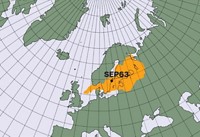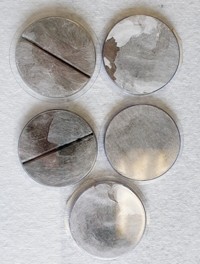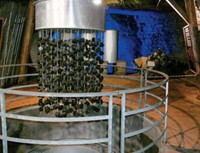Advertisement
Grab your lab coat. Let's get started
Welcome!
Welcome!
Create an account below to get 6 C&EN articles per month, receive newsletters and more - all free.
It seems this is your first time logging in online. Please enter the following information to continue.
As an ACS member you automatically get access to this site. All we need is few more details to create your reading experience.
Not you? Sign in with a different account.
Not you? Sign in with a different account.
ERROR 1
ERROR 1
ERROR 2
ERROR 2
ERROR 2
ERROR 2
ERROR 2
Password and Confirm password must match.
If you have an ACS member number, please enter it here so we can link this account to your membership. (optional)
ERROR 2
ACS values your privacy. By submitting your information, you are gaining access to C&EN and subscribing to our weekly newsletter. We use the information you provide to make your reading experience better, and we will never sell your data to third party members.
Environment
Klaus Mayer
Forensics team leader investigates European nuclear materials of unknown origin
by Sarah Everts
January 12, 2009
| A version of this story appeared in
Volume 87, Issue 2
WHEN A FORMER drug dealer notified police in the small German town of Lauenförde that he no longer wanted the 14 uranium pellets long hidden in his garden, Klaus Mayer got a phone call.
Mayer is head of nuclear forensics at the European Commission's Institute for Transuranium Elements (ITU), which does the detective work when nuclear material mysteriously appears across the country and, often, across the continent. Located in Karlsruhe, Germany, ITU is one of a handful of organizations around the world—another one is Lawrence Livermore National Lab, in California—that specializes in nuclear forensics, a field of research that bloomed in the 1990s, when tight control of nuclear material in states of the former Soviet Union disintegrated. As everything from weapons-grade plutonium to nuclear power plant fuel pellets became part of the black market economy, scientists with expertise in nuclear chemistry were increasingly called on to play detective and to determine the provenance of trafficked material. "We are often asked to figure out where the material originated, what its use was, and who was its last legal owner," Mayer says.
Although the dissolution of the Soviet Union sparked the establishment of nuclear forensics—more than 200 cases of illicitly trafficked material have been recorded by the International Atomic Energy Agency (IAEA) since the early 1990s—Mayer is quick to point out that the field got its start in 1949, when U.S. planes surreptitiously traversing Russian airspace took airborne particle samples that revealed the country's first nuclear bomb test.
These days, scientists employ a variety of techniques to discern a nuclear material's provenance. Radiometric devices, such as gamma spectrometers, measure the type of radioactivity and a rough enrichment level. Mass spectrometry determines precise isotopic fractions and identifies chemical impurities, both of which provide clues to the material's source. Optical, scanning electron, and transmission electron microscopy reveal the sample's structural properties. Because radioactive elements are heavy and therefore electron-rich, scanning and transmission electron microscopy are particularly useful for nuclear forensics.
Although developing new techniques for nuclear forensics is "interesting from a scientific point of view," nuclear forensic researchers must be careful to make any conclusions using conventional methods for cases that may end up in the judicial system, Mayer says. "If the case goes to court, the method needs to be well established," he adds. "Very new, very fancy techniques are easily challenged there because everything is subject to the Daubert standard for evidence," which excludes from the courts the presentation of scientific conclusions from untested protocols, he says.
So the small team at ITU has used established methods to pinpoint the source of a variety of nuclear materials: from a vial of Russian weapons-grade plutonium confiscated at a Munich airport to radioactive metal from a dismantled nuclear facility in the Middle East that was brought to a Dutch scrap-metal yard. The ITU team has also helped to solve a case in which a worker involved in dismantling a German nuclear reprocessing plant stole some radioactive waste. The man stored the radioactive vials, as well as tainted cloths, in his apartment, exposing himself to high levels of radioactivity. His girlfriend was also exposed and even ingested some of the radioactive waste. The man was put under surveillance after workplace urine tests, a routine part of the nuclear safety procedures, revealed unusually high levels of radioactivity.
BUT BACK to the German garden. Although much of the nuclear material trafficked in the past decade emerged from the former Soviet states, it took the ITU team one day to figure out that the pellets dug out of the garden in Lauenförde could not have come from the former Eastern Bloc but probably originated from Germany itself. First of all, the enrichment of radioactive uranium-235 was 3.4%, Mayer says, which doesn't correspond to uranium enrichments in former Soviet nuclear power plants. Then, comparing the diameter and height of the nuclear pellets and examining the overall machining details with an ITU database of European and former Soviet Union nuclear power plant fuel specifications made it clear that the source was a Siemens factory in Hanau, Germany.
The team concluded that the nuclear pellets were produced in 1990, failed a quality-control test in the factory, and were subsequently stolen and then sold to the drug dealer in Lauenförde, who was hoping to sell them illegally. After failing to do that for more than a decade—they are absolutely worthless for making weapons, Mayer says—the dealer turned to the police, who turned to ITU.
"Classic smuggling scenarios," such as the Lauenförde case, in which nuclear power plant material is trafficked, are becoming less typical, Mayer says, because smugglers are realizing that converting a nuclear power plant pellet into a weapon requires sophisticated know-how and a lot of nuclear material.
Although petty theft cases are no longer as common as before—IAEA reported that there were 10 cases of nuclear trafficking in 2006, down from 45 in 1994—nuclear forensics will continue to grow, Mayer says. Fueling that growth are the increasing concerns among G-8 member nations and IAEA about global terrorism and, specifically, terrorists with nuclear capability.
As for himself, Mayer says the mix of "international law enforcement, radiochemistry, and materials science" keeps him interested in the field. "Each sample or situation is unique and specific, and there's no routine," he says.






Join the conversation
Contact the reporter
Submit a Letter to the Editor for publication
Engage with us on Twitter